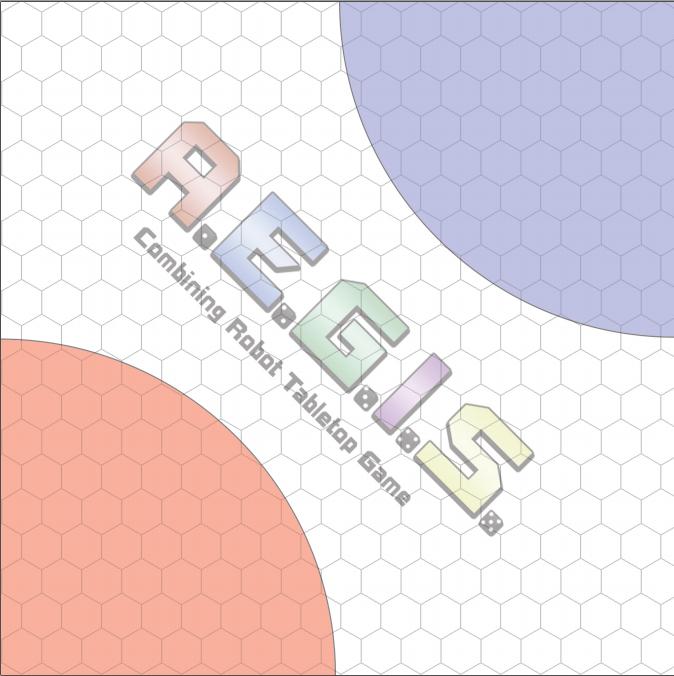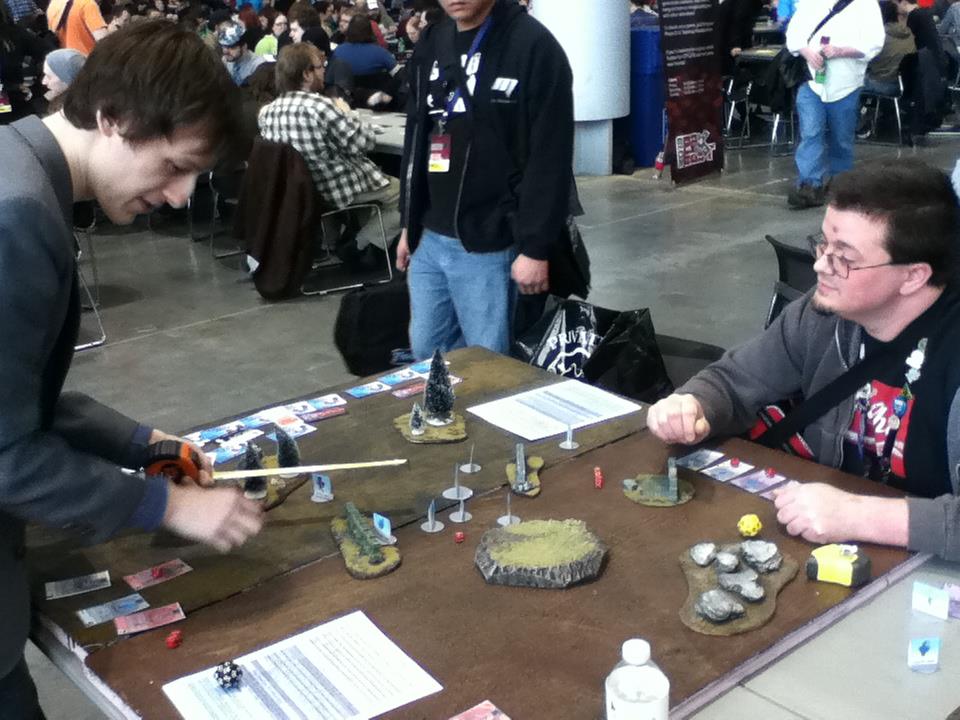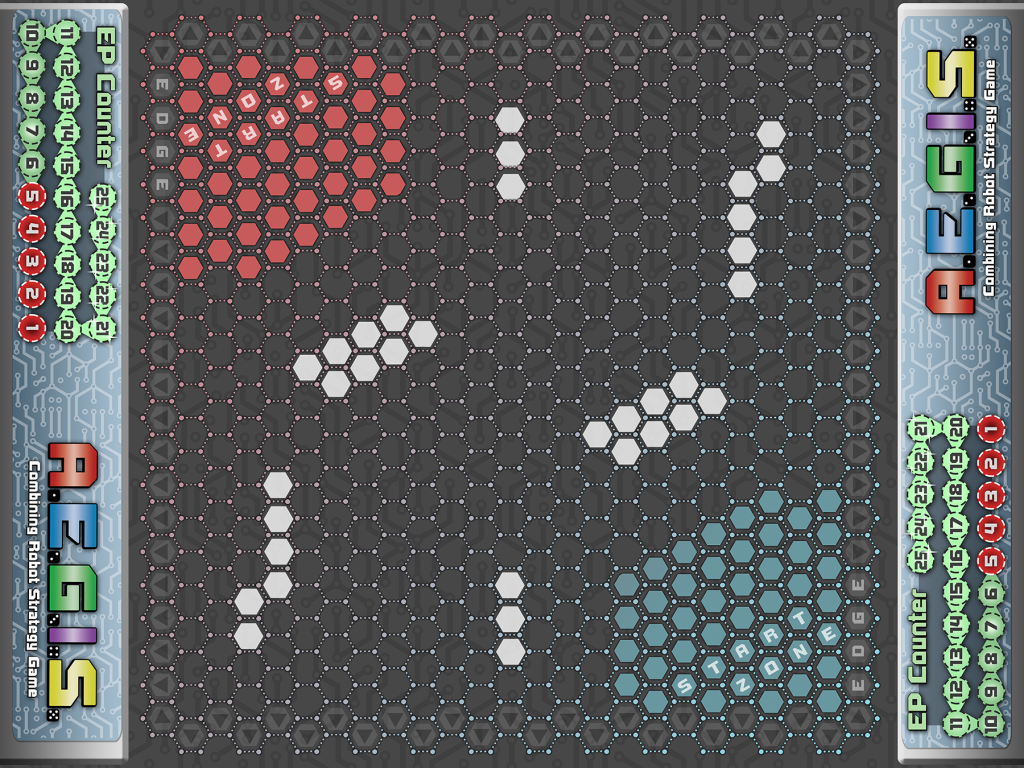#2: A Game Mat to Call Home

Breeze Grigas
There are many, many blog entires I’d like to make about A.E.G.I.S., but with the rapid development we’ve been spending so much time on in the last few months, I just haven’t had the time to write them. Our little game has a lot of thought put into just about every single aspect of it, from the design of the five Classes and each individual robot there-in, to the art design, to the naming schemes of the 100+ weapons/actions our robots have, to the characters and universe, that it’s a bit daunting to choose which thing to talk about first.
So today I’ve decided to start somewhere so the topics don’t keep piling up. Today I’m going to talk about probably the most important aspect of actually playing A.E.G.I.S. – where you play it.
Inching Along…
A.E.G.I.S. began development solely as a traditional wargame, a game where movement and distances are literally measured with a ruler. There were a number of reasons for this, the main one being that I personally wanted to create a wargame that would seem appealing to a more casual, simple game-loving audience. The more traditional wargames had very high learning curves, set up times, time investment and tons of monetary expenses, as well as being very long games to actually play.
This original version of the game-play was made not only to be playable on your standard 4′ x 4′ or 4′ x 6′ Warhammer terrain, but also playable in much smaller spaces where we encouraged players to use any old objects as terrain pieces. Players could play on any table, with them starting in opposite corner zones that varied in size. At one point we played a game or two on top of the 1.5′ x 1.5′ trash thing at Barnes and Noble, with some little art supply boxes off the shelf as terrain.
Infinite Possibilities, Finite Audience
A.E.G.I.S. was always vaguely meant to work on both inches, and on a hex grid. We had our game demo in many places by many people and, while the “Play any time, anywhere!” model was pretty accurate, we came to the conclusion that giving players that much freedom is a bad thing. A.E.G.I.S. was made to be a very quick, accessible game, but the act of setting up playspace and giving completely free range of movement stretched the time to actually play the game out by almost double. Although wargaming veterans looked at the game favorably, many players that were meant to be in our audience were immediately turned off by the sight of a ruler. We needed to “code-ify” things, and reduce the amount of free thought that came into setting the game up and doing things between player decisions.
Before the Boston Festival of Indie Games, we finally created a hex grid for the game to play on without altering anything else. As we expected, the game worked on the hexes pretty well, and we only needed to make minor rules changes to assure everything in the future would work fine.

We continued to use this board for several months afterwords, and we made note of all the problems we noticed in game-play. The players were engaging each other far too early, the starting zones were too large and the board itself (number of hexes-wise) was too small. It was a 19×19 grid where in some circumstances players would assault the other before the second player had moved. Certain robots could move across half the board, and everything felt very cramped.
Keeping track of energy usage each turn was mentally doable for most, but also taxing and it slowed the game down. We had the idea of making it trackable on paper. Supplying physical terrain was also a thing that could be a detriment to experiencing the game too. We considered all of these factors when we made this:
What you’re seeing here is the final version of our play mat. Physically smaller, properly labeled, visually attractive and very utilitarian, this poster paper game board is what is packaged with our Arc Buster and Sky Guard Starter Sets.
Breaking the Game Down
To wrap up, let’s go over the features of this game board:
- Light-weight, foldable and 2’x1.5′ in size, small enough to fit on most flat spaces.
- Easy to pull out and put away, letting you break the game down at any time.
- 21×25 Hex grid. Large enough for free movement without running into the attack range of every other robot, small enough so the game moves quickly. There are 15 spaces between the starting zones, a good distance in a game where the average effective attack range is about 6-8 spaces.
- On-Map Terrain. No longer is it a necessity to find terrain to play. You still can, but now it’s right there on paper!
- Labels! You know where and what the starting zones are and that the board has edges where you can be pushed off.
- The EP Counter! A sliding gage where you can use a die or token to easily, thoughtlessly keep track of your Energy Pool each turn so you’re focusing on the strategy and not your memory.
Moving Forward, Inch by Inch
The best part about all this is that A.E.G.I.S. can still be played on inches like it always has been. We’ll be packaging in rules for both the hex game-play (Standard) and inch game-play (Advanced). So cheers to all gamers out there!


